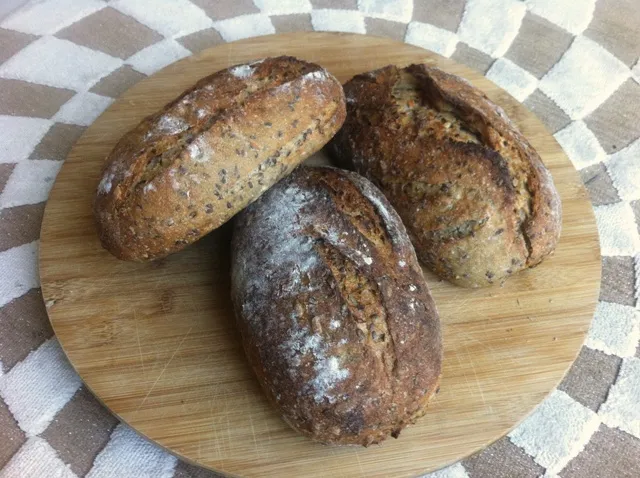Dark Rye with Raisins & Sunflower Seeds
- Log in or register to post comments
- 27 comments
- View post
- Franko's Blog

... lots of things.
First of all,
Happy Chanukkah, Happy Thanksgiving!
Now about my baking - I didn't have so much time for blogging recently, but I am still baking on!
My wife gave me a copy of Yotam Ottolenghi's book "Jerusalem", a great book if you like mediterrean food. Not so much about baking.

A Trial Version of Stollen
Followed the Recipe word by word as I havent got any bitter almond nor bitter almond oil I have left that out in this recipe. Will definitely add it when it comes to gift time.
A crumb shot will be posted when I have it cut up.
It smells so good when its cooking in the oven. cant wait to try it out.

Started this loaf on Monday night, using the recipe at the link below. I liked it and will definitely make it again. We had it for lunch when it was hot--a bit too hot. Had to have lunch early with turkey in the oven! Happy Thanksgiving to everyone.

I increased my recipe by 50%, hand shaped two circles, used a spinach and garlic filling. It filled my pizza pan. Can't wait until dinner to taste it. If it tastes as good as it smells, it'll be yummy!

I nearly missed out that you guys are celebrating thanksgiving today. So for this occasion, and also because I had to bake something for the bread baking day, organized by www.kochtopf.me, here is my focaccia that we had today. A perfect autumn food that went well with our tomato soup tonight.
The recipe features whey, an overnight fermentation and some beautiful olives and sun dried tomatoes with some Grand Padano on top. Delicious stuff that focaccia i have to say. Enjoy your festival :)

We really love this simple recipe which is equal parts sourdough starter and flour (I did 1 cup to make a small pizza, 1-1/2 for larger), tablespoon of olive oil, and teaspoon of salt. Let it sit for 30 minutes and then roll it out very thin. Just bake it on a pizza stone at 500 degrees for four minutes or so, take it out and coat with olive oil to seal, and then add your ingredients. Bake it for 5 or so more minutes, and it's done. Fantastic. We really enjoyed it.
Two more Christmas pudding reviews on my blog here, I have another 10 (at least) to get through!!


The practical classes have finally commenced after a 3 week halt due re-location. We have had the cold desserts last weekend, featuring popular desserts such as Pana Cotta, fruit flavored cold soufflés, and Mousses, in addition to crepes, fruit fritters, and rice pudding. Most desserts featured below contain gelatine to set them. It goes without saying that everything was exceptionally delicious! We have still few classes left for cold desserts then we’ll be off to hot desserts and later chocolate.